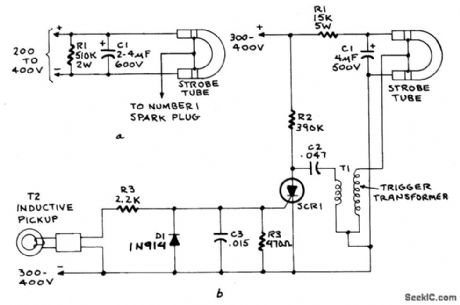LED and Light Circuit
IGNITION_TIMING_LIGHT
Published:2009/7/3 3:35:00 Author:May | From:SeekIC

Figure A shows the circuit of a direct-trigger timing light. The trigger voltage is taken from the car's ignition circuit by a direct connection to a spark plug. A circuit using an inductive pickup is shown in Fig. B. A trigger transformer is used to develop the high-voltage pulse for triggering. The triggering circuit consists of T1, C1, SCR1, inductive pickup coil T2, and the waveshaping components in the SCR's gate circuit.When the spark plug fires, it induces a pulse in pickup coil T2 that triggers the SCR gate. The SCR fires and discharges C2 through the primary of T1. The secondary of T1 feeds a high-voltage pulse to the trigger electrode of the flash tube. That pulse causes the gas-usually neon or xenon-to ionize. The ionized gas provides a low-resistance path for Ct to discharge, thereby creating a brilliant flash of light.Resistor R1 limits current from the supply as the tube fires. When C1 is fully discharged the strobe tube cuts off and returns to its high-resistance state. The current through R2 is not enough to sustain conduction through SCR1, so it cuts off and remains off until it is re-triggered by a gate pulse.
Reprinted Url Of This Article:
http://www.seekic.com/circuit_diagram/LED_and_Light_Circuit/IGNITION_TIMING_LIGHT.html
Print this Page | Comments | Reading(3)

Article Categories
power supply circuit
Amplifier Circuit
Basic Circuit
LED and Light Circuit
Sensor Circuit
Signal Processing
Electrical Equipment Circuit
Control Circuit
Remote Control Circuit
A/D-D/A Converter Circuit
Audio Circuit
Measuring and Test Circuit
Communication Circuit
Computer-Related Circuit
555 Circuit
Automotive Circuit
Repairing Circuit
Code: